|
This section contains 392 words (approx. 2 pages at 300 words per page) |
Paramecium are single celled eukaryotes, reminiscent of a football in shape, that belong to the group of microorganisms known as the Protozoa. The protozoan inhabits freshwater bodies such as ponds. The organism is useful as a teaching tool for light microscopy.
There are at least eight species of Paramecium. Two examples are Paramecium caudatum and Paramecium bursaria.
Paramecium are large enough to be visible to the unaided eye. However, the internal detail is resolved only by the use of a microscope. A student is best able to observe the complex internal organization of the organism by using what is termed the hanging drop technique. Here a drop of water is suspended upside-down on a cover slip that is positioned over a cavity on a microscope slide. The cover slip is sealed to prevent leakage.
Paramecium contain organized structures called vacuoles that are essentially a primitive mouth, stomach, and excretion system. As food enters the organism, it is stored in specialized vacuoles known as food vacuoles. These can circulate through the cytoplasm of the organism, in order to provide food where needed. Characteristic of eukaryotes, nuclear material is segregated by a nuclear membrane.
Another characteristic features of Paramecium is the so-called contractile vacuole. This vacuole is able to store water and then, by virtue of the compression of the side arms that radiate from the central vacuole, to expel the water out of the organism. In this way, the amount of water inside the paramecia can be controlled. The operation of the contractile vacuole is another feature that is visible by the light microscopic observation of living paramecia.
On the exterior lies a membrane that is called the pellicle. The pellicle is both stiff, to provide support and to maintain the shape of the organism, and is flexible, to allow some flexing of the surface. Also on the surface are hundreds of tiny hairs called cilia. The cilia wave back and forth, and act to sweep food particles (bacteria and smaller protozoa) towards the primitive mouth of the organism (the gullet). The cilia are also important in locomotion, acting analogous to the oars of a rowboat. The beating of the cilia is easily visible under light microscopic examination, especially if the movement of the organism has been retarded by the addition of a viscous compound such as glycerol to the sample.
|
This section contains 392 words (approx. 2 pages at 300 words per page) |


